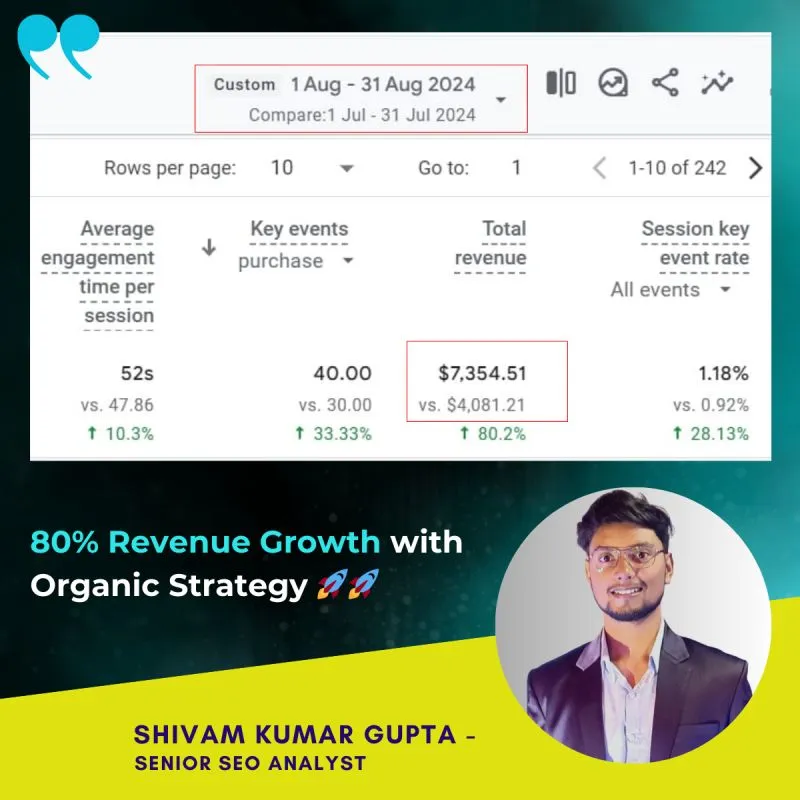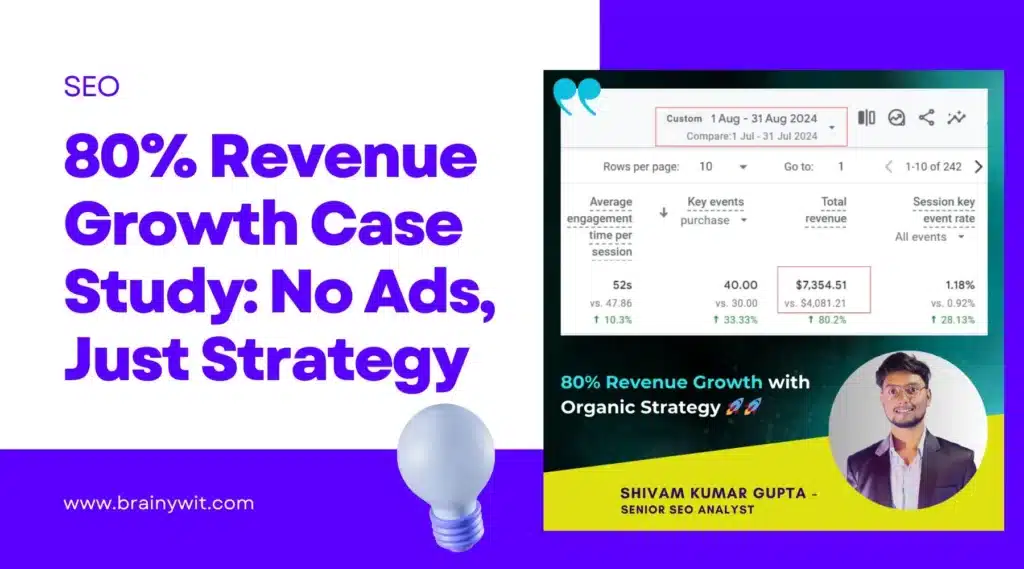Growing revenue without a hefty ad budget can feel unrealistic—especially in a hyper-competitive eCommerce market. But when you tap into what’s already working under the surface, it becomes more than possible.
That’s exactly what we discovered when working with Hot Cup Factory, a client whose primary focus had shifted toward other business ventures. Despite having an active eCommerce store, the site had remained untouched for nearly two years.
Yet, when we reviewed its Google Search Console data, the signals were clear: thousands of keywords were already indexed, and the site was getting solid impression volume—just not the clicks or conversions it deserved.
We saw an opportunity hiding in plain sight.
By running a detailed technical audit, performing a complete taxonomy overhaul, and deeply optimizing their core product and collection pages, we were able to boost their revenue by 80.2%—in just one month—without spending a single rupee on ads. From $4,081.21 to $7,354.51, the transformation was both fast and rooted in organic strategy.
This case study walks through the exact framework we used to deliver this growth, including technical audit insights, the taxonomy we implemented, and the content structure we designed. Every step was tailored to fit the brand’s current position—and accelerate its path to top-5 keyword rankings.
Let’s break it down.
Table of Contents
ToggleProject Background & Initial Discovery
Hot Cup Factory is one of three brands owned by a fast-growing packaging entrepreneur in the U.S. While their flagship business, Frozen Dessert Supplies, was receiving the lion’s share of attention, Hot Cup Factory had been operating on autopilot for over two years—no content updates, no SEO strategy, no structural improvements.
At first glance, it seemed like a forgotten domain. But under the hood, things were different.
After gaining access to their Google Search Console, we found:
A surprisingly strong indexation footprint
High impression counts on dozens of commercial-intent keywords
Multiple product and collection pages sitting between positions 10–20 on SERPs
The brand wasn’t lacking in opportunity—it was lacking optimization.
We pitched the owner a plan to reclaim Hot Cup Factory’s organic potential. Backed by real search data and growth projections, the proposal focused on:
Leveraging non-brand search intent
Restructuring the website to match modern eCommerce SEO standards
Increasing revenue without increasing ad spend
With approval secured, we kicked off the project by downloading full keyword data via Ahrefs and mapping everything into a clean content brief to guide our efforts.
This discovery phase wasn’t just about identifying gaps—it was about turning hidden potential into measurable outcomes.
Our Strategy Framework
Our objective was clear: unlock untapped organic revenue by improving structure, search alignment, and page-level intent. But the execution required precision.
We used a layered approach—starting with analysis, then realignment, followed by deep optimization of the most commercially valuable parts of the site.
1. SEO Opportunity Audit & Keyword Discovery
We began with a comprehensive keyword extraction using Ahrefs and Google Search Console. The goal was to map:
Existing ranking keywords (positions 6–30)
Keywords with commercial intent but low CTR
Pages receiving impressions but underperforming in clicks
This helped us uncover over 1,400 keyword opportunities across product and collection pages.
We organized all findings in a working keyword and content brief, enabling us to:
Prioritize high-intent, non-brand keywords
Align top pages with keywords that users were already searching
Plan internal links and page clusters accordingly
2. Competitor Analysis & Content Gap Mapping
Next, we benchmarked Hot Cup Factory’s structure and content against top 3 direct competitors on Google. Our analysis focused on:
SERP format (titles, schema, structure)
Depth of content on collection and product pages
Keyword and phrase usage across the page
We noticed the top competitors had:
More optimized product filters and FAQs
Clearer content hierarchies
Stronger use of buyer-focused modifiers (e.g., “bulk hot cups,” “wholesale,” “eco-friendly”)
By creating a competitor matrix, we documented the exact content gaps we needed to fill—leading to sharper targeting and faster rank lifts post-optimization.
3. Taxonomy Design & SERP Intent Alignment
Most eCommerce sites fail not because of content, but because of structure. We redesigned the site’s taxonomy to align with both searcher intent and product logic.
We used this taxonomy document to organize collection and product categories under clear, crawlable hierarchies.
Improvements made:
Standardized URL structure for all collections
Grouped products by purchase behavior (size, use case, material)
Created internal linking relationships across top collections
This restructuring also allowed us to reduce orphan pages and gave Google a clear map of topical authority.
4. On-Page Optimization of Core Pages
We prioritized collection pages as revenue drivers. Each was optimized for:
Title and meta rewrites (with primary keywords up front)
On-page copy updates to meet intent and boost dwell time
Alt-text and image optimization
Embedded FAQ schema for snippet eligibility
Structured headings and bullet points for better mobile scannability
Once collection pages were handled, we moved on to product-level SEO. This included:
Cleaning up duplicate content
Enhancing product descriptions with real use-case language
Adding semantic LSI variations
All updates followed findings from our technical audit, which uncovered dozens of issues impacting crawlability and ranking potential.
Results That Speak for Themselves
Once we implemented the core structural and on-page optimizations, the results didn’t just trickle in—they surged.
Without running a single paid ad, Hot Cup Factory saw major lifts in both engagement and revenue across key performance indicators.
Revenue Growth in 30 Days

In just one month, the store’s revenue jumped from $4,081.21 to $7,354.51—an 80.2% increase, all through organic search.
What made this possible wasn’t just more traffic—it was better traffic. By targeting commercial non-brand queries, we attracted buyers with real intent. And because the product and collection pages were fully aligned to their needs, conversions followed.
Engagement & Behavior Signals Boost
Higher rankings only matter if users stay, click, and convert. We closely monitored metrics like:
Engagement time
Scroll depth
Click-to-cart rates
Here’s what changed:
Avg. engagement time increased by 10.3%
Bounce rates dropped significantly on high-traffic collection pages
Users spent more time exploring related products through improved internal links
These behavior shifts signaled to Google that users were finding what they wanted, further supporting ranking gains across multiple pages.
Key Conversion Metrics Improved
Conversions weren’t just up because of visibility—they were up because of intent-matching experiences.
From our GA4 and Shopify reports:
Key actions (add-to-cart, checkout initiations) grew by 33.33%
Session events aligned with purchase behavior increased by 28.13%
High-intent non-brand queries became a larger share of total organic traffic
What made the difference? We removed friction, answered questions up front, and matched users to the exact product they were seeking.
Lessons Learned & What This Means for You
This case reinforced a core principle we see time and time again: you don’t need more content—you need more alignment.
Despite being inactive for over two years, Hot Cup Factory’s site held unrealized potential simply because the structure, content, and user intent weren’t in sync. Once we addressed those issues methodically—using real data, not guesses—the results followed fast.
Key Takeaways:
Indexation ≠ Optimization
A site being indexed doesn’t mean it’s optimized. Rankings only improve when intent, structure, and quality meet.Structure scales faster than content
A good taxonomy (like this one) can turn 5 optimized pages into 50 high-performing ones just by unlocking internal link flow and discoverability.SEO is a compound asset
One month of focused effort can generate long-term value if your technical foundation is sound. Unlike ads, these gains don’t disappear the moment you stop spending.
The biggest win? We didn’t write a single blog post. All growth came from optimizing what already existed. That’s the power of strategic SEO over content bloat.
Conclusion: Growth Without Ads Isn’t a Dream—It’s a Strategy
This project wasn’t about hacks, tricks, or flooding the site with content. It was about tapping into what was already working—then amplifying it with technical precision and intent-driven optimization.
- We didn’t spend on paid campaigns.
- We didn’t rewrite the brand.
- We didn’t publish dozens of new pages.
Instead, we audited what existed, realigned the structure using this taxonomy system, fixed foundational issues with a clear technical audit, and followed a content strategy brief rooted in real buyer behavior.
The result?
An 80.2% increase in revenue in just one month, without a single dollar spent on ads.

Shivam is an AI SEO Consultant & Growth Strategist with 7+ years of experience in digital marketing. He specializes in technical SEO, prompt engineering for SEO workflows, and scalable organic growth strategies. Shivam has delivered 200+ in-depth audits and led SEO campaigns for 50+ clients across India and globally. His portfolio includes brands like Tata Motors, Bandhan Life, Frozen Dessert Supply, Indovance, UNIQ Supply, and GAB China. He is certified by Google, HubSpot, IIDE Mumbai, & GrowthAcad Pune.





